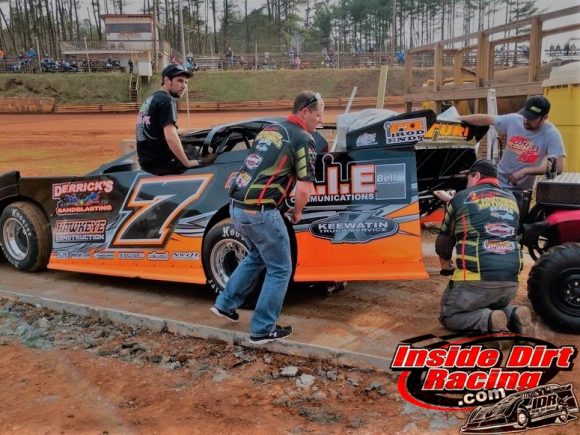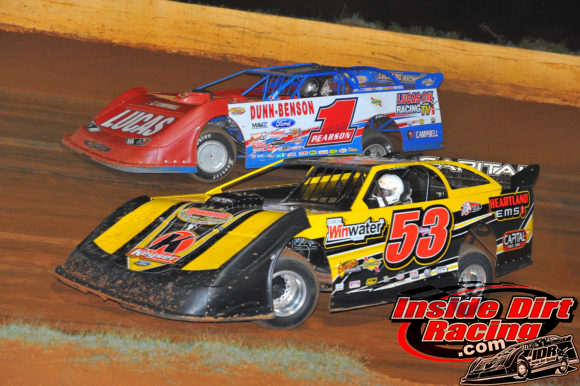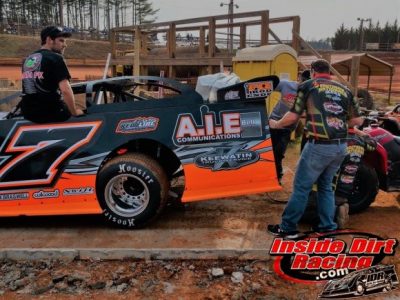During the PRI Trade Show this past December in Indianapolis, series promoter and Tri-County Race Track owner Ray Cook announced a rule change that would take effect in his Southern Nationals Series family of races for the 2018 season. Dubbed the ‘Droop Rule’ the new measure calls for each car competing in the Southern Nationals, Spring Nationals, and Southern Nationals Bonus Series to have a chain attached to the left rear suspension for the purpose of limited the distance of up-and-down travel by the left rear of the car. In theory, the rule is intended to reduce the number of roll over crashes among Dirt Late Model race cars by keeping the rear of the car lower to the ground.
The revelation of the new rule brought both praise and criticism, particularly on the various forms of social media frequented by those in the racing world.
With the unfortunate timing of rain and other unfavorable weather conditions, the rule had yet to go into effect until Friday night’s running of the Southern Nationals Bonus Series race at Tri-County Race Track in Brasstown, NC. Shane Clanton became the first driver to win a feature event in which the ‘Droop Rule’ was in use.
In a video produced during the PRI Trade Show, Cook proclaimed, “Tech has been sort of a joke over the past year-and-a-half or two years with these deck heights in the back simply because we have a lot of smart people in our industry and they have basically figured out how to manipulate the rules so their cars can get higher and higher when they pull on the race track and go down the straightaway.”
Cook addressed the pre-race inspection issue following Friday night’s race via text message with InsideDirtRacing.com. “I will say that was one of the more stress free nights I’ve had in a while,” the promoter proclaimed. “It makes tech so easy and no arguments. I was very pleased.”
From the competition standpoint, it seemed as if the new rule had little bearing on the racing itself. A total of 21 cars entered the race which is a solid number for a $3,000-to-win event held on a track that is not exactly located near a major population center. So apparently, competitors were not scared away by the prospect of a new rule and tech inspection procedure.

Driver Ricky Weiss and crew chief Shawn Gage look on as Southern Nationals officials check the left rear of their car
Further, qualifying times were among the fastest ever turned on the quarter-mile oval. Clanton was fastest overall with a time of 12.536 seconds. The track record for the high-banked facility was established by David Payne in 2017 at 12.243 seconds. It would appear as if the new rule did little to take speed away from the cars.
Cook said in the PRI video that the height of the car’s rear deck served to increase speed. “What engineers and the people who work on these cars have figured out is that the higher they get this spoiler, the faster the car goes,” he pointed out.
More from the competition standpoint, Clanton dominated the race by leading all 40 laps. But that should not necessarily have come as a surprise from a former World of Outlaws Craftsman Late Model Series champion. However, the racing behind the race leader for other positions was good as drivers exchanged spots at high speed.
The race winning driver had some stern words for those who have criticized the rule.
“All these people need to lay this to rest and try this one time instead of just doing what they’re doing and bad mouthing a rule change,” Clanton stated. “I mean, we get new rules everyday. If they thought this rule was faster, I guarantee you every one of them would have it on there. Every one of them need to just put it on one time and come out and try it.”
From the perspective of a crew chief, Blount Motorsports leader David Bryant, who prepares cars for Casey Roberts, also offered his observation following the first night with the new stipulations in place.
“Yeah, it’s definitely a change,” Bryant said. “I don’t think it’s a bad rule at all. We just have a learning curve to go through.”

Ray Cook believes that rear deck heights on Late Models like his own #53 have been allowed to get too high
Cook believes the ‘Droop Rule’ will ultimately make racing safer, as he declared during his PRI video.
“The purpose for this new rule we’re putting in for 2018 is simply for safety. That’s all it’s about. We’re not trying to slow the cars down. We’re not trying to take any engineering out of the race car, we’re not trying to take any shocks or springs away. All we’re trying to do is get the cars back down closer to the ground to where they’re harder to turn over.”







